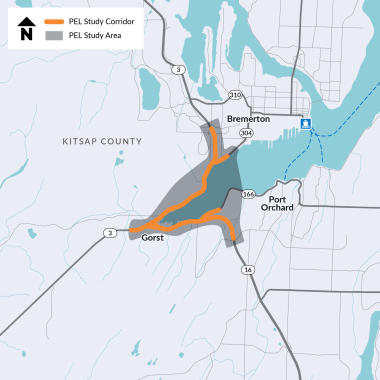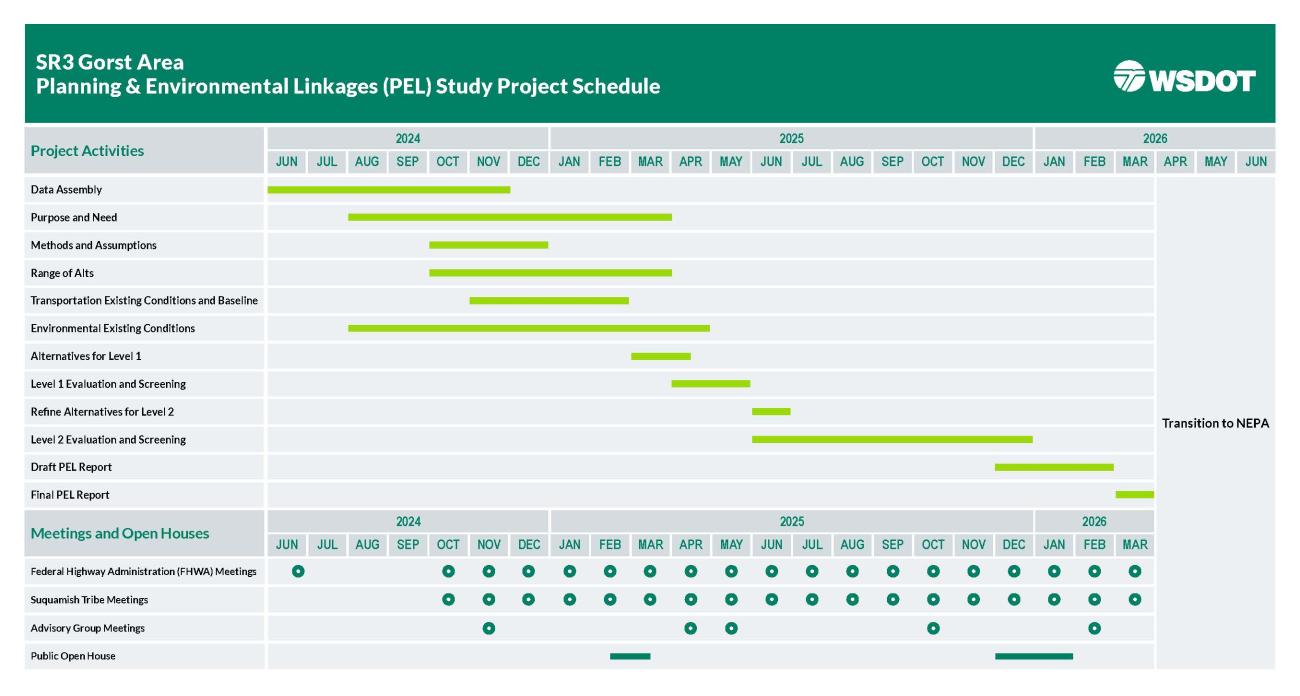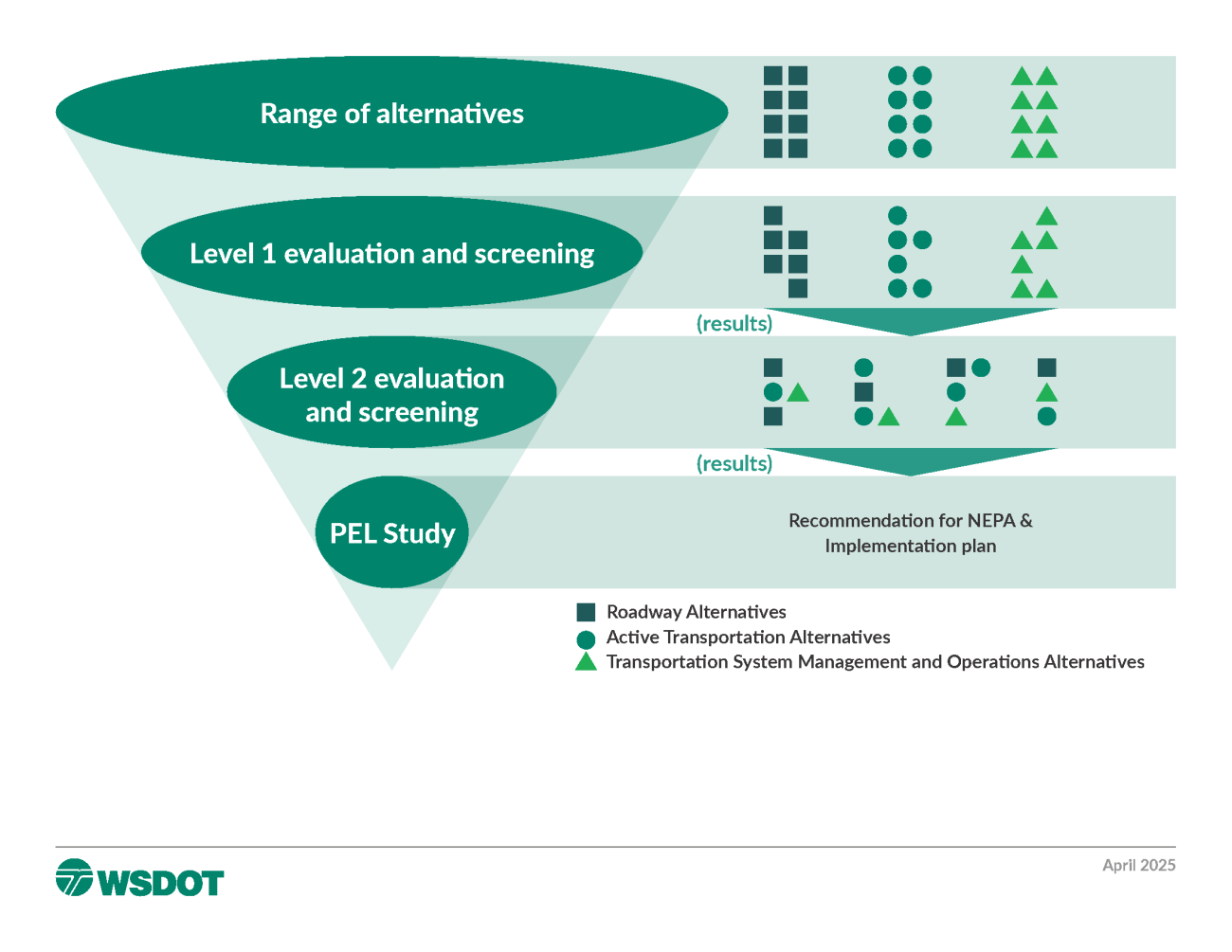Planning study news
In June 2024, WSDOT began a Planning and Environmental Linkages (PEL) study to look at State Routes (SR) 3, 16, 166 and 304 in the Gorst area. This study evaluates a range of alternatives that improve transportation for all roadway users.
Key study partners, including tribes, state, local, and federal agencies, and community members, who will be invited to review and share input on the recommended alternatives in fall and winter 2025. WSDOT expects to complete the alternatives evaluation process in early 2026. After the PEL study is complete, recommended alternative(s) will move into the environmental review process.
Purpose
WSDOT and study partners defined the study’s Purpose as:
- Mobility: Improve person throughput and reduce congestion and delay for all vehicle modes.
- Safety Performance: Improve existing safety performance in terms of fatal and serious injury crashes and promote designs with fewer conflicts and greater separation for vulnerable roadway users.
- Active Transportation: Provide active transportation access with connections to local active transportation facilities.
- System Resiliency: Implement a resilient design that supports anticipated future travel demand growth
Mobility on State Route 3 and SR 16 in Gorst is significant for the entire region. Each highway is important for matters of national security. Both state highways are the only land-based route to the Kitsap Peninsula and experience congestion. The key routes are susceptible to liquefaction due to earthquake. There also is the potential for issues related to sea level rise.
The SR 3 Gorst Planning and Environmental Linkages Study includes meeting with the Federal Highway Administration, tribal nations, specifically the Suquamish and Skokomish Tribes, advisory groups, businesses, and the community.
WSDOT received $82.5 million from Move Ahead Washington funds for the design and right of way phases. There is currently no funding for construction.
Community engagement
Environmental Justice Assessment
The Healthy Environment for All (HEAL) Act is an environmental justice law. The HEAL Act works to reduce environmental and health impacts in Washington. Under the HEAL Act, this study will perform an environmental justice assessment (EJA).
The EJA will help WSDOT identify potential negative impacts of the study. WSDOT aims to reduce potential impacts to vulnerable and overburdened groups. The EJA process ensures that the community has the chance to help shape decisions on this study.
Tribal consultation
The Suquamish Tribe and Skokomish Indian Tribe are vital study partners. They proide guidance to the study team on the development and evaluation of early design concepts. Our tribal partners inform us on culturual resources, historical sites, and land and fishing rights. They area lso invited to attend our Technical and Executive Advisory Committees.
Community partner interviews
In October 2024, we held six listening sessions with community groups. Read a summary of these listening sessions (PDF 1.2MB).
Pop-up events
On February 21, 2025, we hosted two community pop-up events. Members of the study team shared materials to introduce the study, shared the draft Purpose and Need statement and range of design concepts and gathered input from the community. The pop-ups were hosted at:
- Coffee Oasis, 822 Burwell Street, Bremerton, from 10 a.m. to noon
- Silver City Brewery Taproom, 206 Katy Penman Ave., Bremerton, from 3 to 6 p.m.
Open houses
Online open house
An online open house was held from Feb. 19 to March 11, 2025. The online open house covered a draft Purpose and Need statement and a draft range of alternatives for SR 3 in Gorst and the surrounding area.
In-person open house
An in-person open house was held on Feb. 26, 2025 at Naval Avenue Elementary School in Bremerton. The open house gave 110 attendees the opportunity to view the draft Purpose and Need statement and range of design concepts and have conversations with our study team.
Business owner outreach
In spring 2025, we met with local businesses to collect feedback on early design concepts. We hosted two virtual information sessions for business owners in the Gorst commercial area on April 28 and April 29. We also shared a survey with businesses to collect information from those who couldn’t attend the virtual meetings. The meetings and survey both collected information about their business’ operations and gathered feedback on the study.
Advisory groups
WSDOT has three advisory groups during the PEL study: a community, executive and technical advisory group. Video recordings, meeting summaries and presentation slides are listed below.
The Community Advisory Group (CAG) is be made up of representatives from community-based organizations, local businesses and institutions, and people with lived experience of travelling in the study area. The CAG will inform the study by sharing input, providing perspective on community values and priorities, and helping share information with community members.
The Technical Advisory Group (TAG) is made up of representatives from resource agencies and public works planning staff. The TAG will support data evaluation and contribute to the development and screening of design concepts.
The Executive Advisory Group (EAG) is made up of elected leaders or similar representatives that also have representation on the TAG. The EAG will inform the study from a policy and governance perspective and represent potential concerns and considerations from their constituents.



